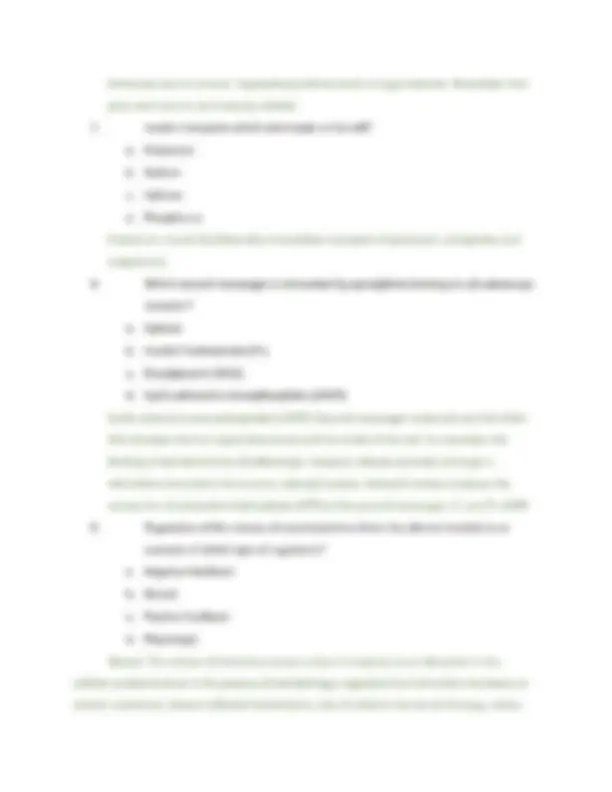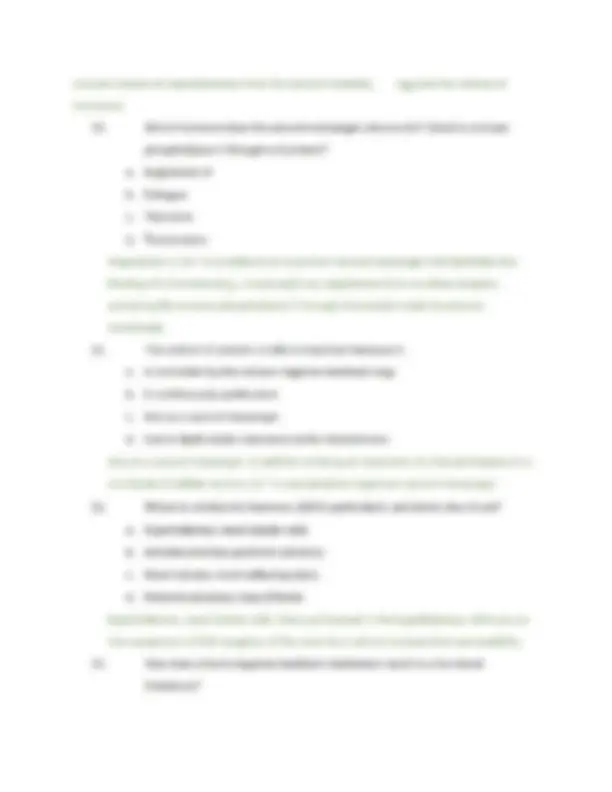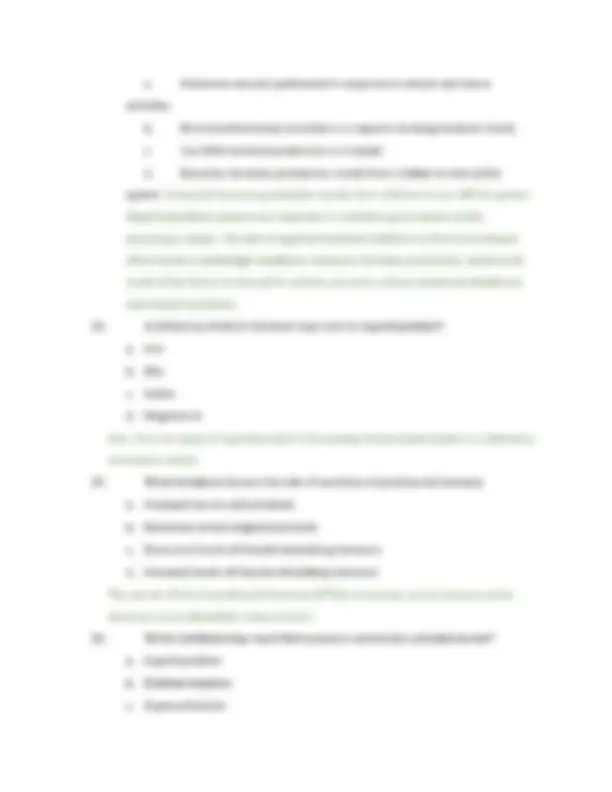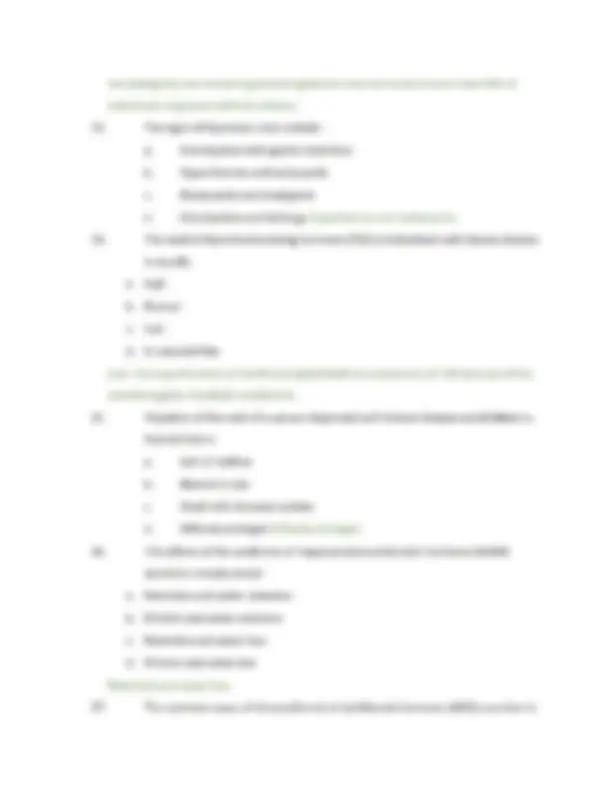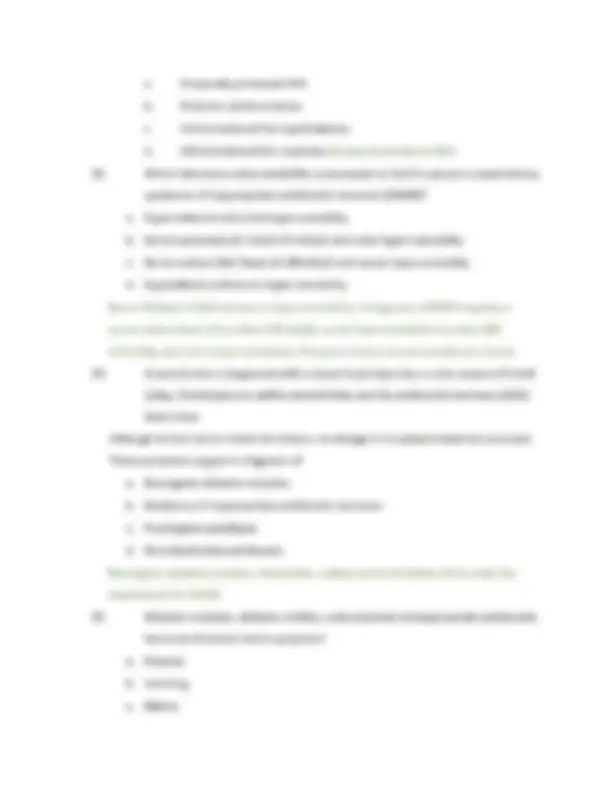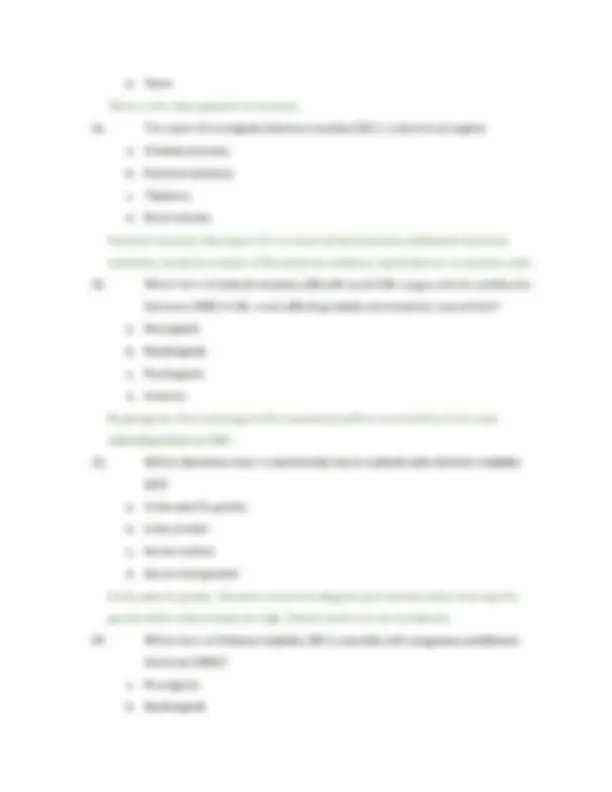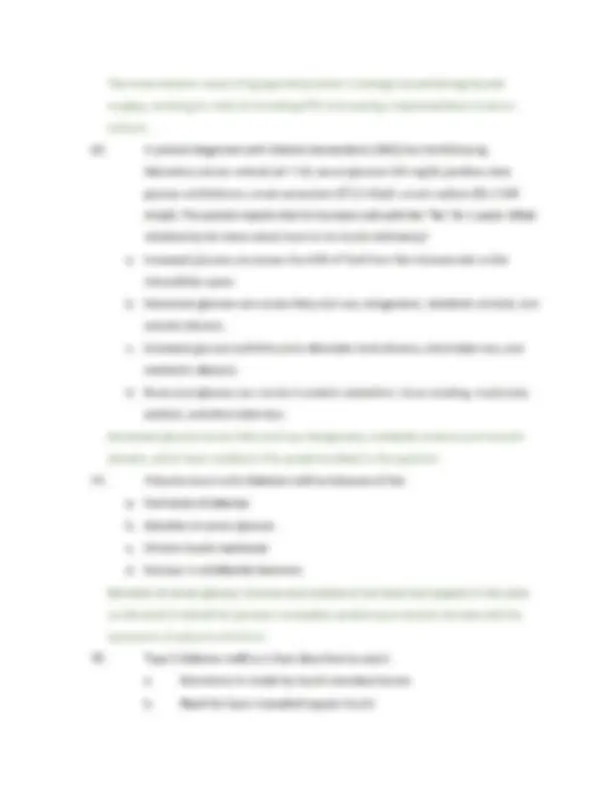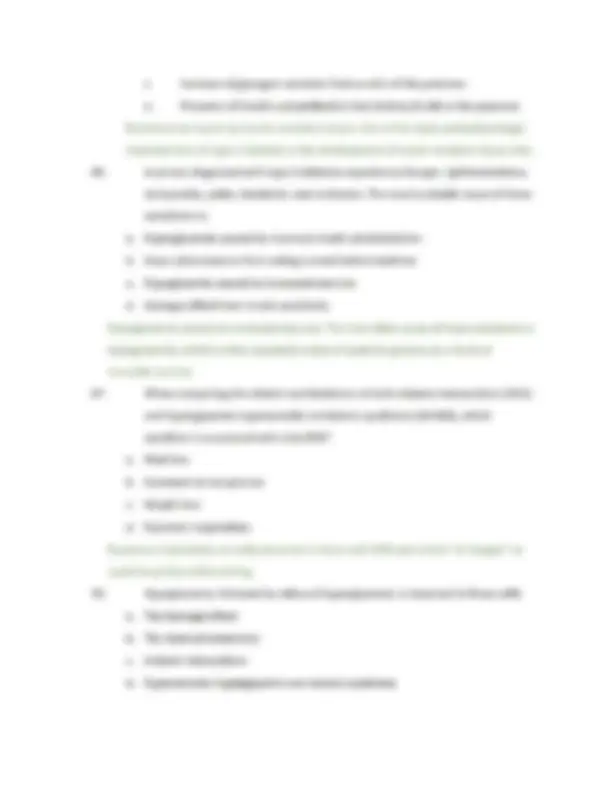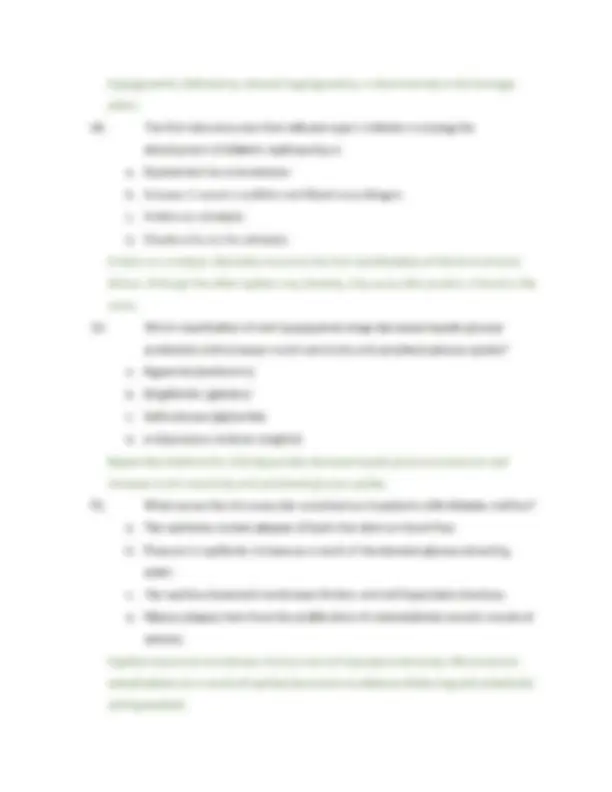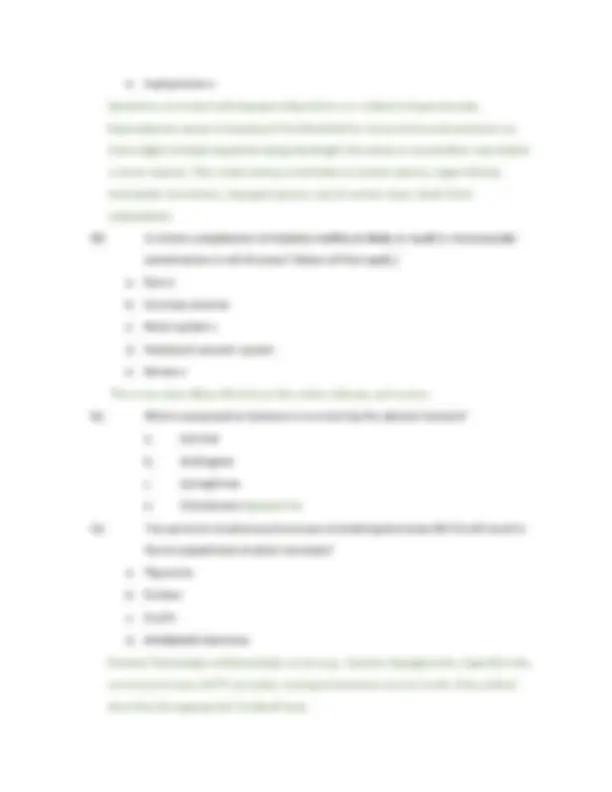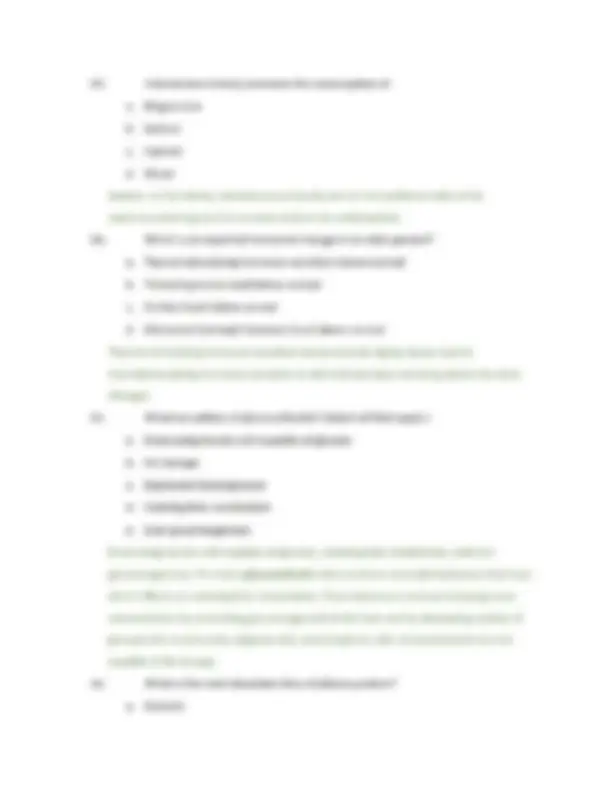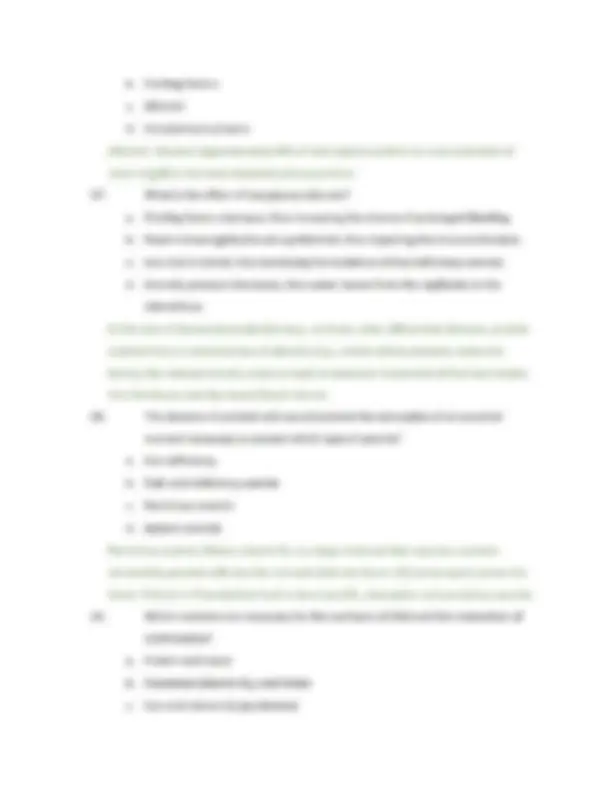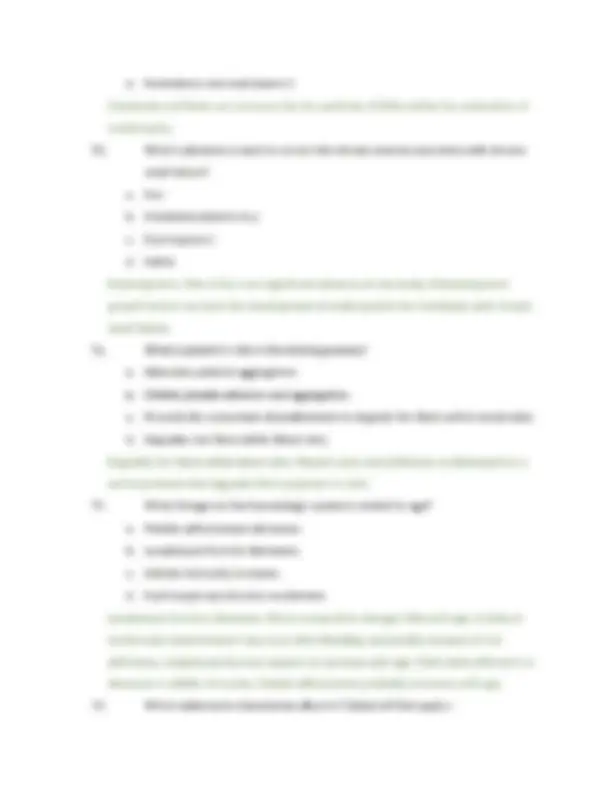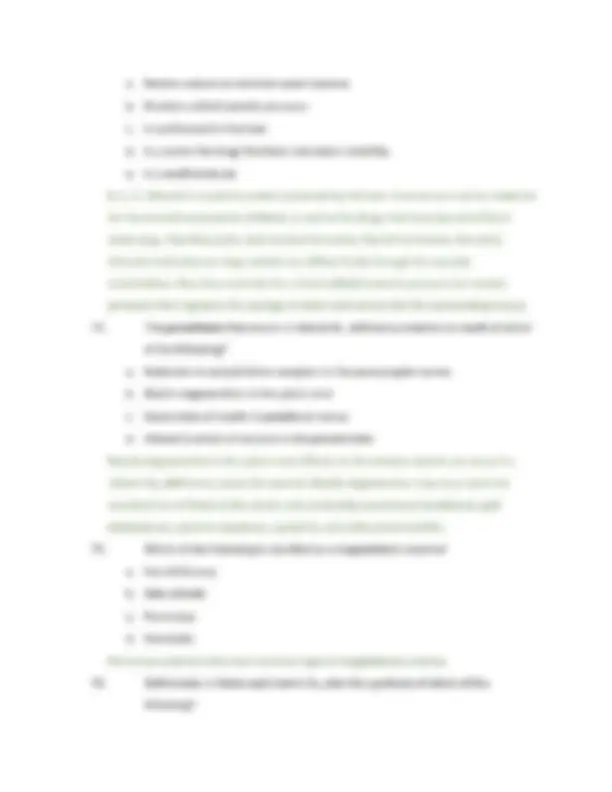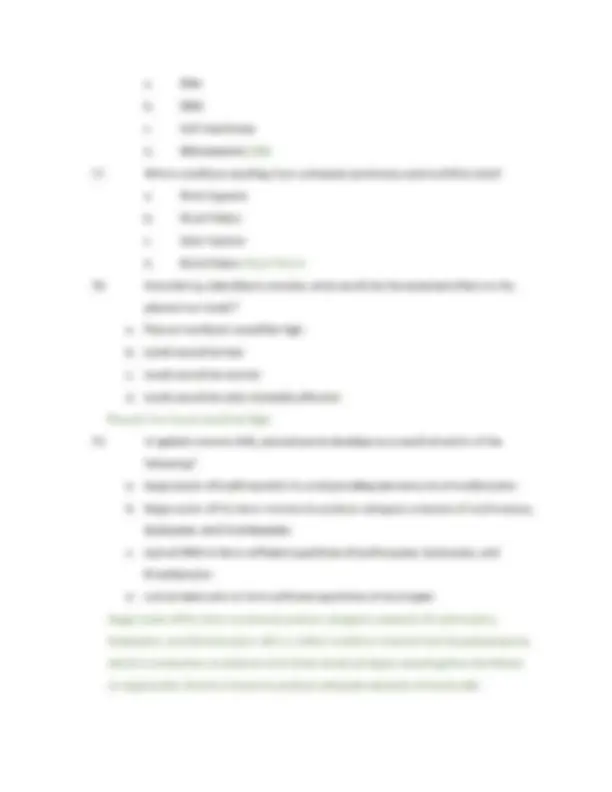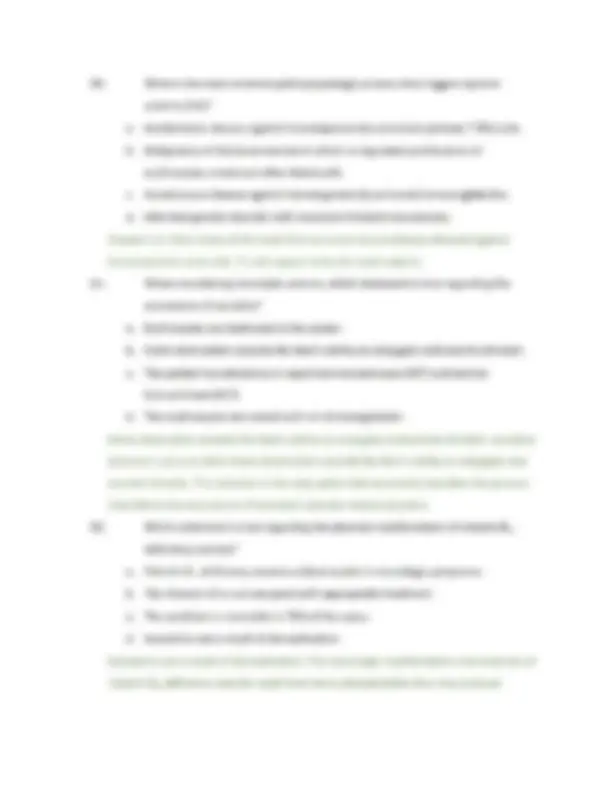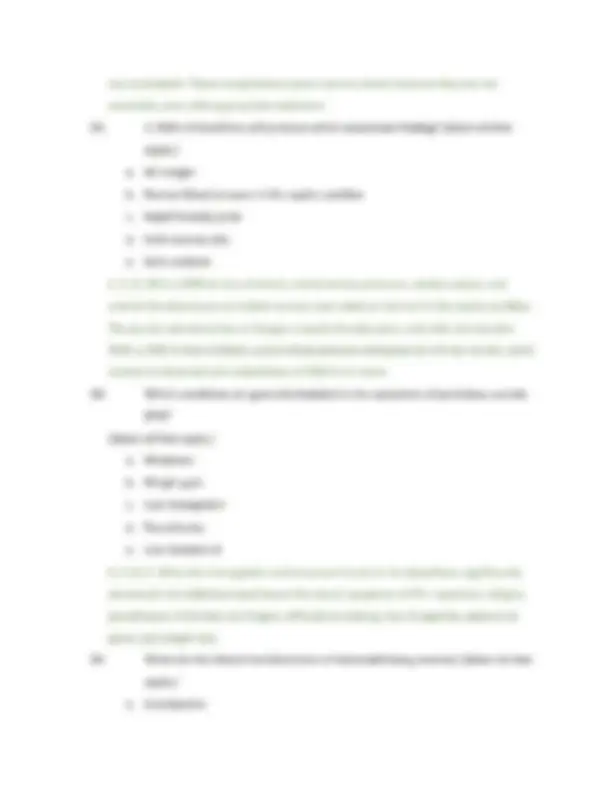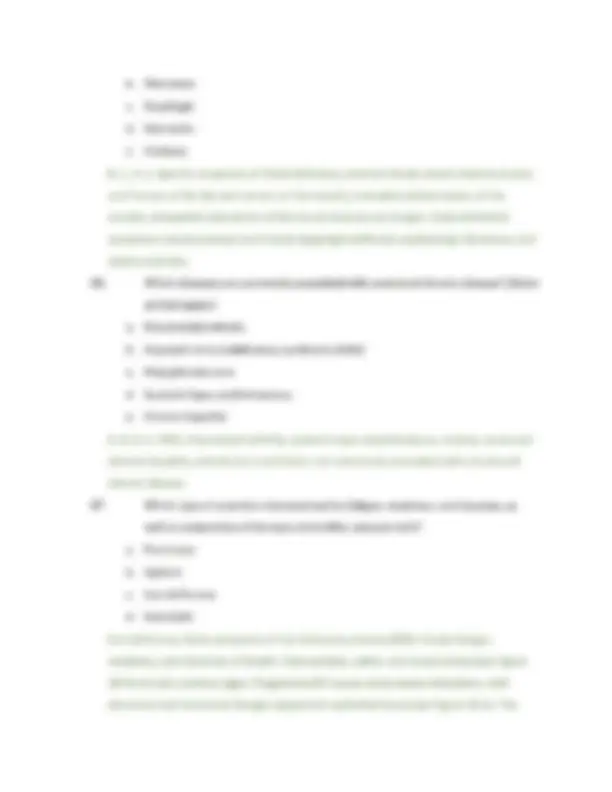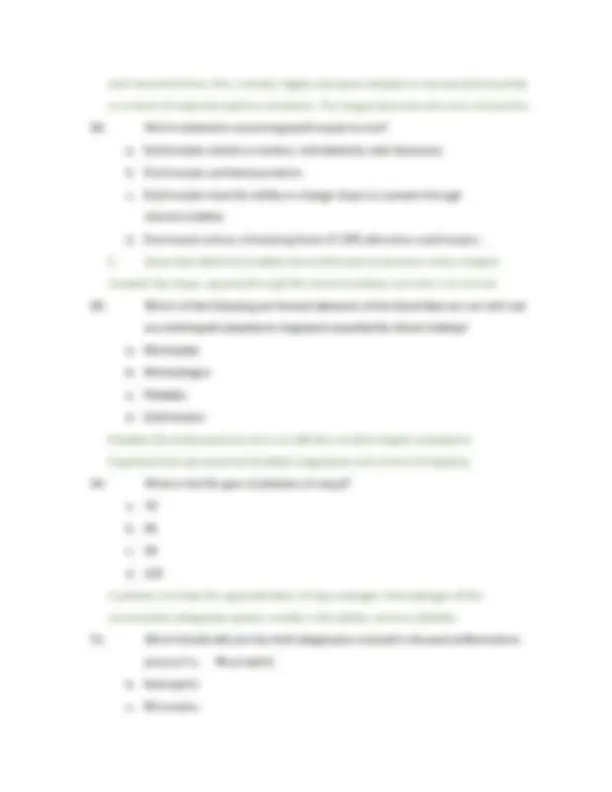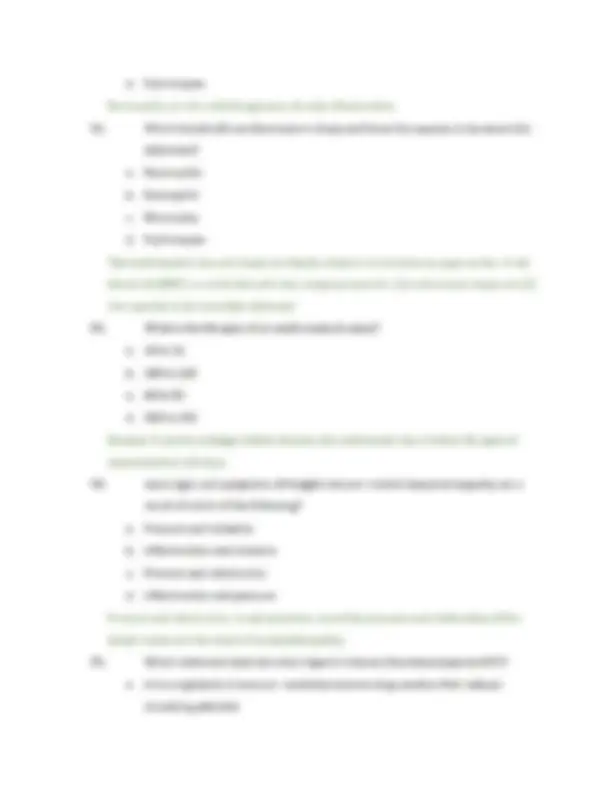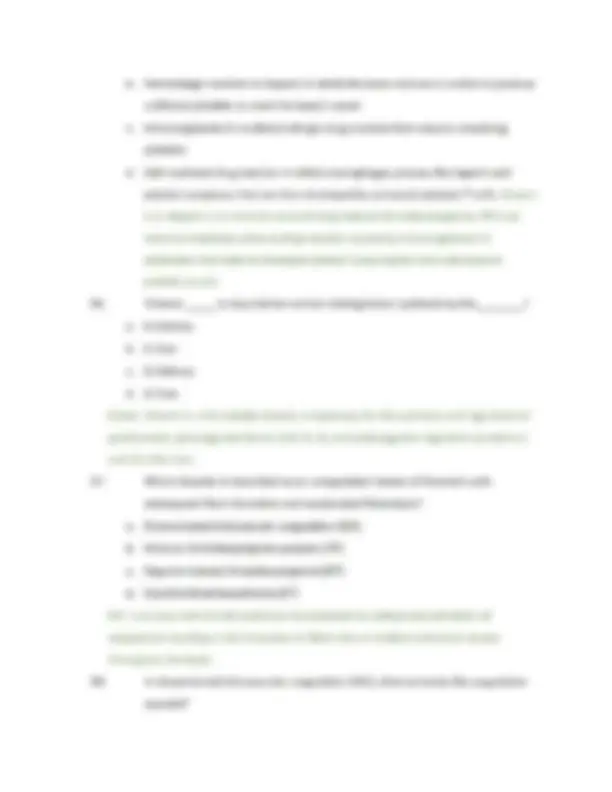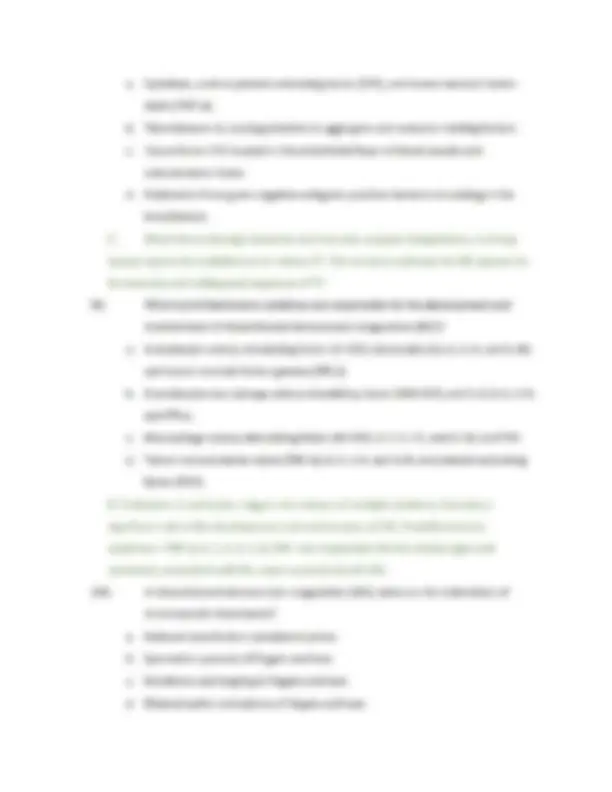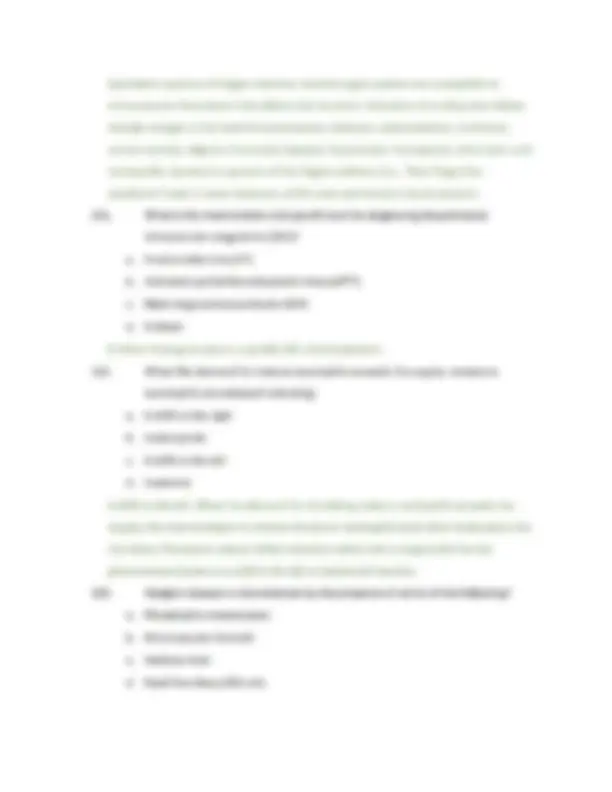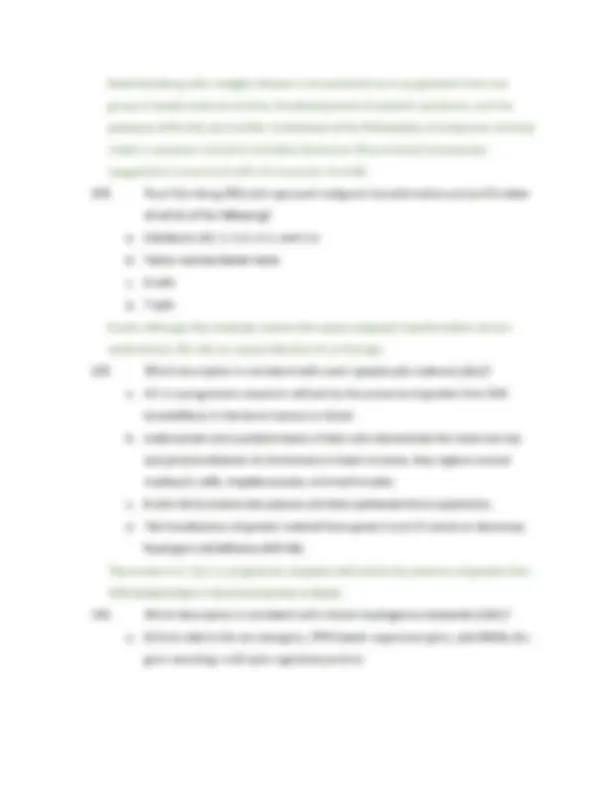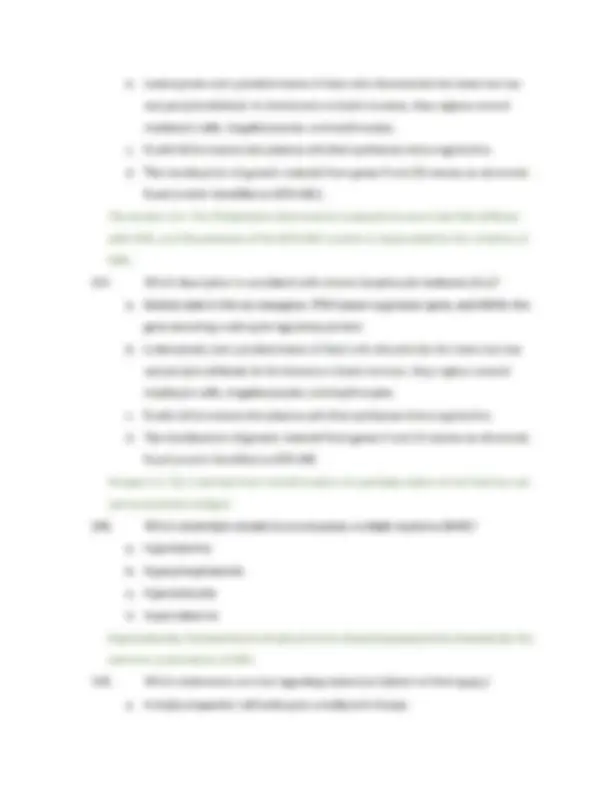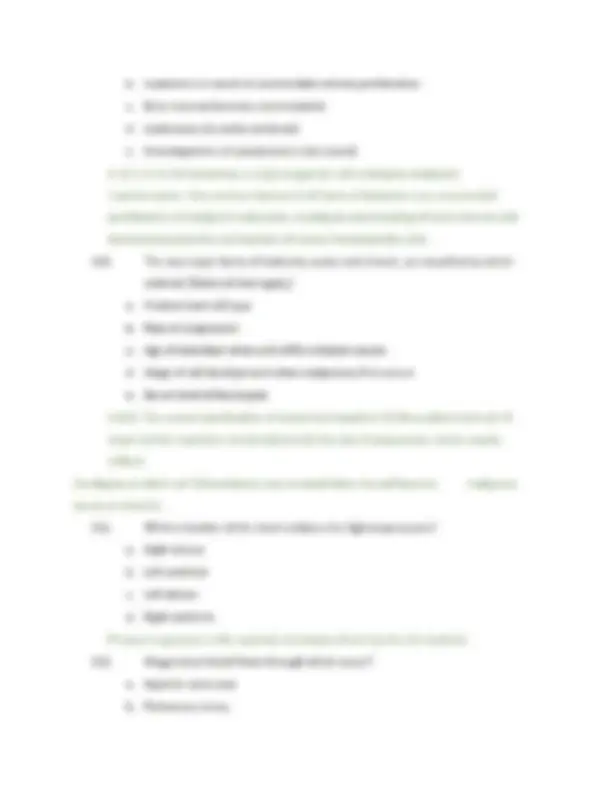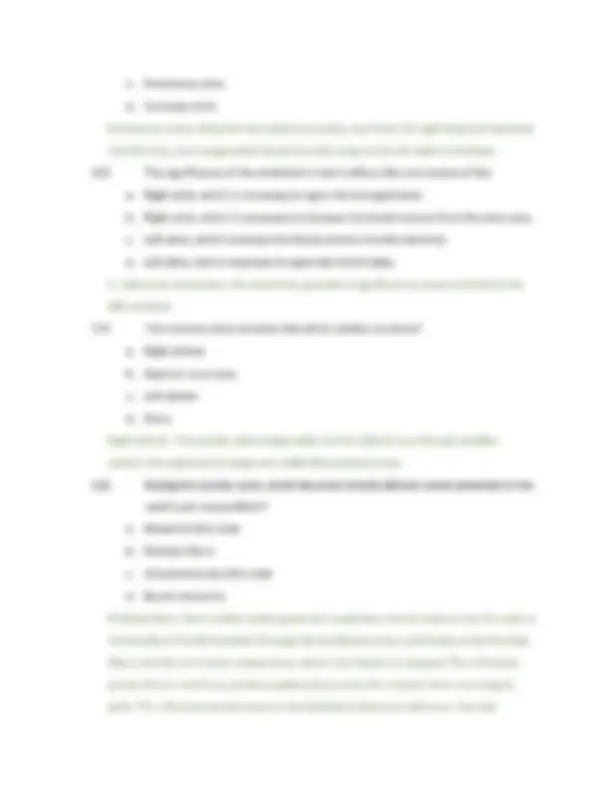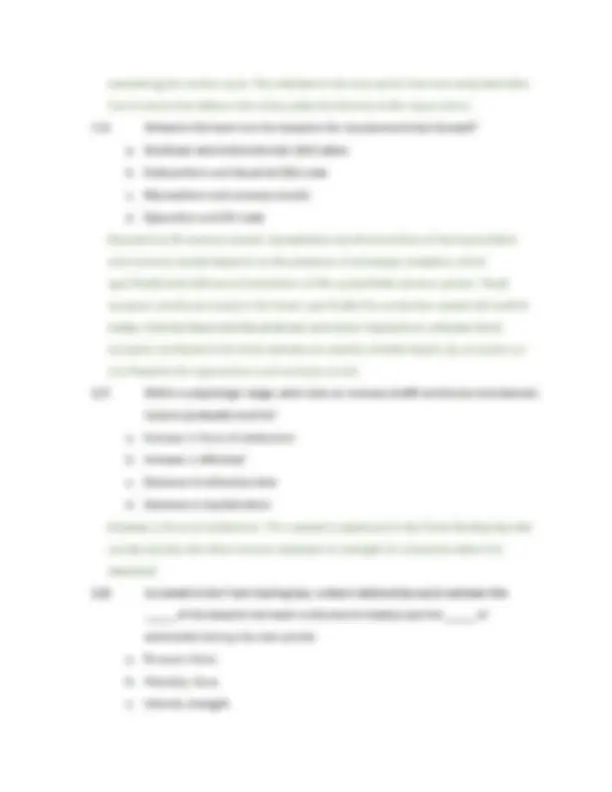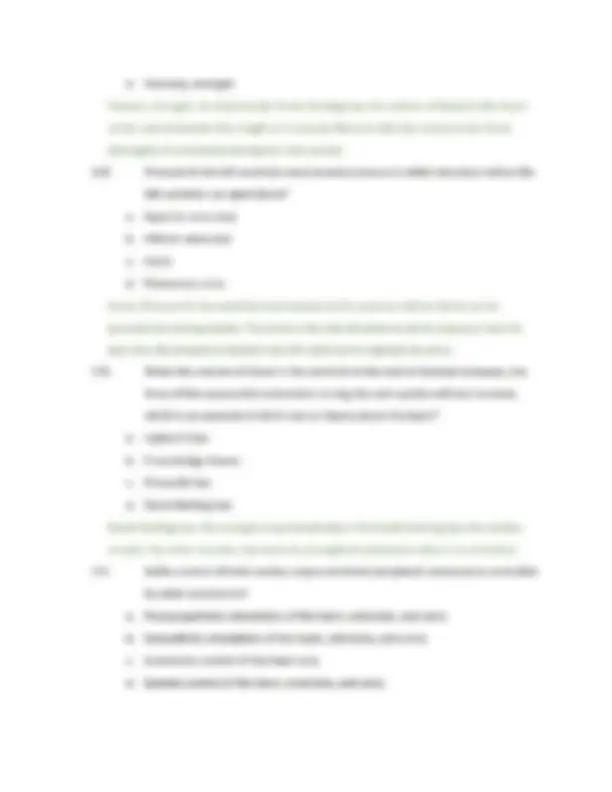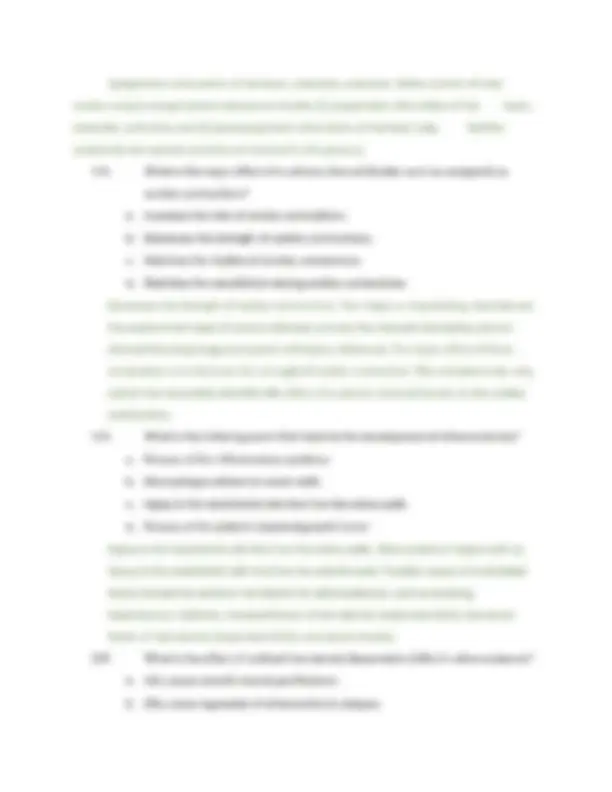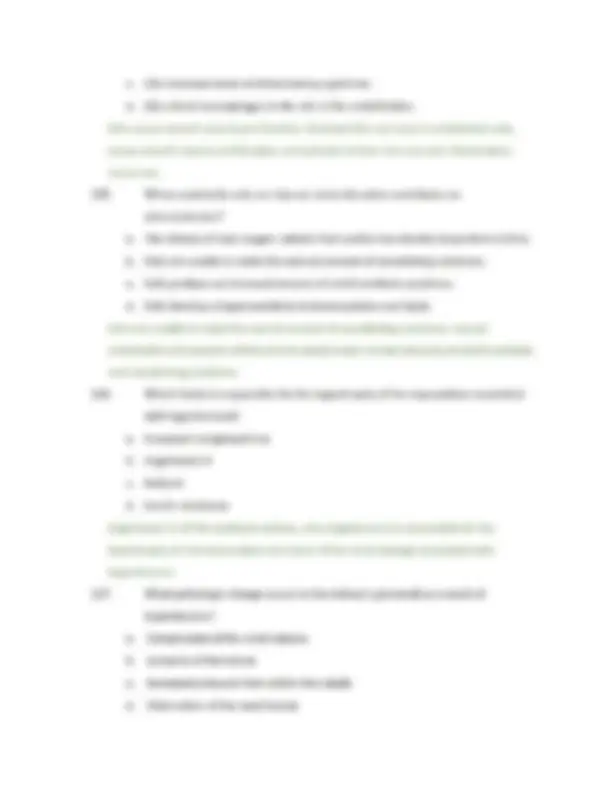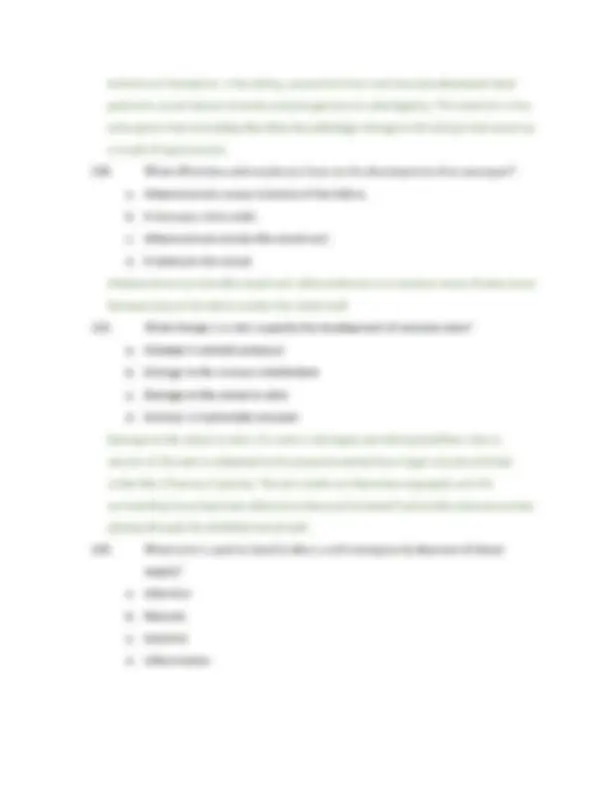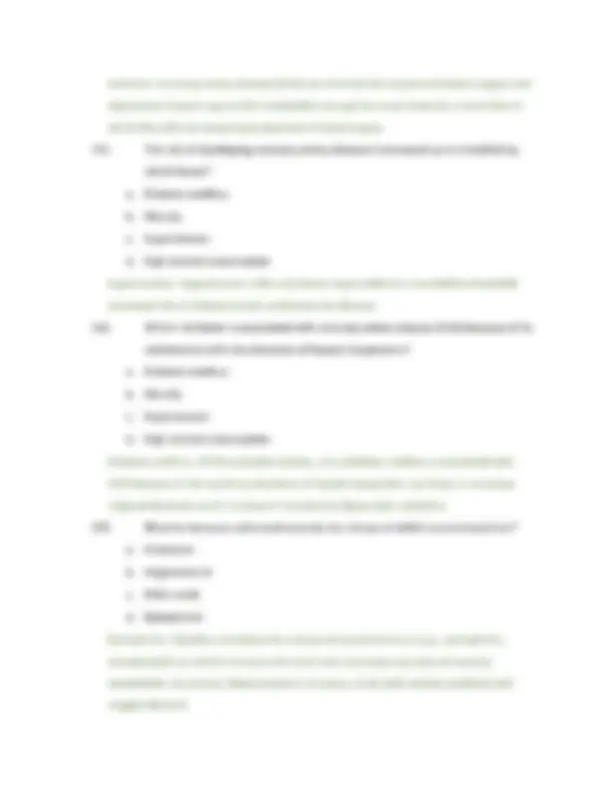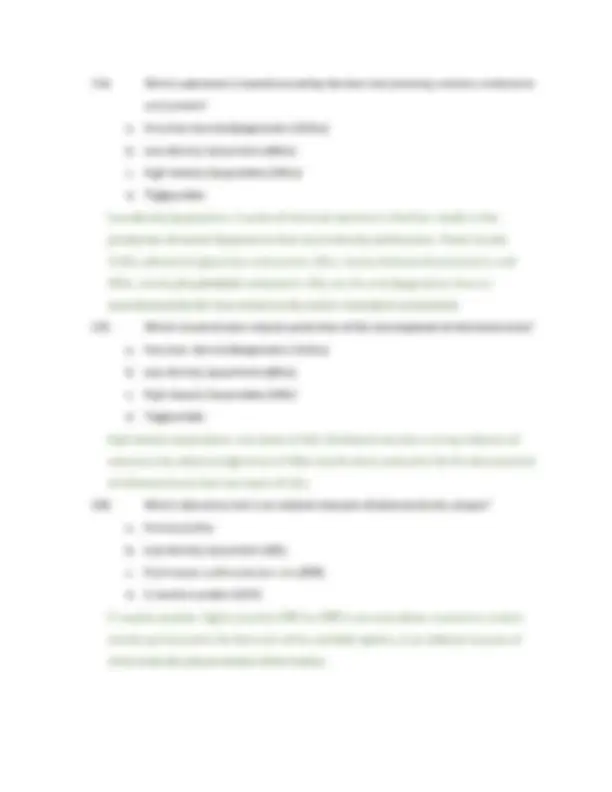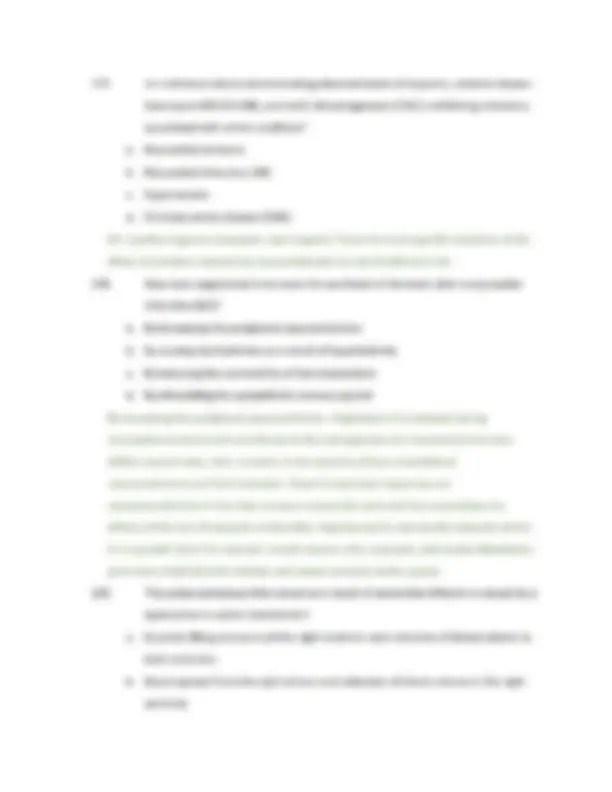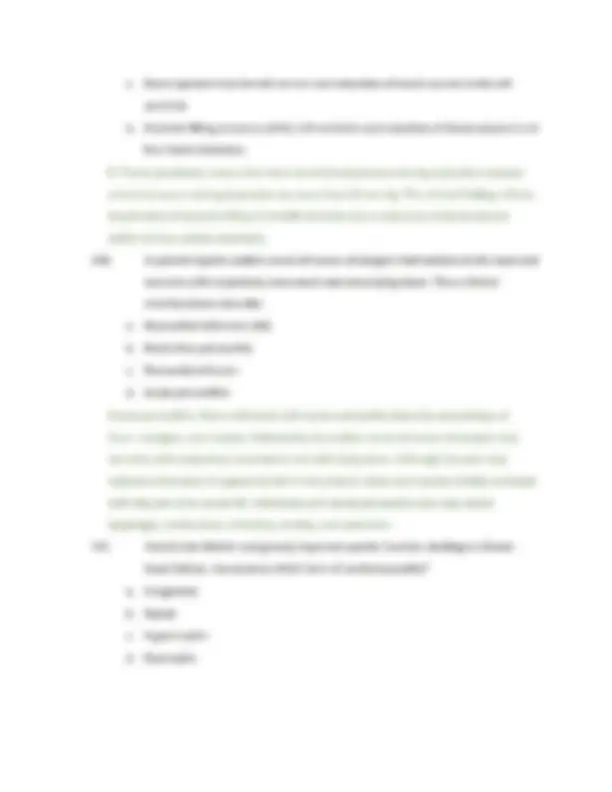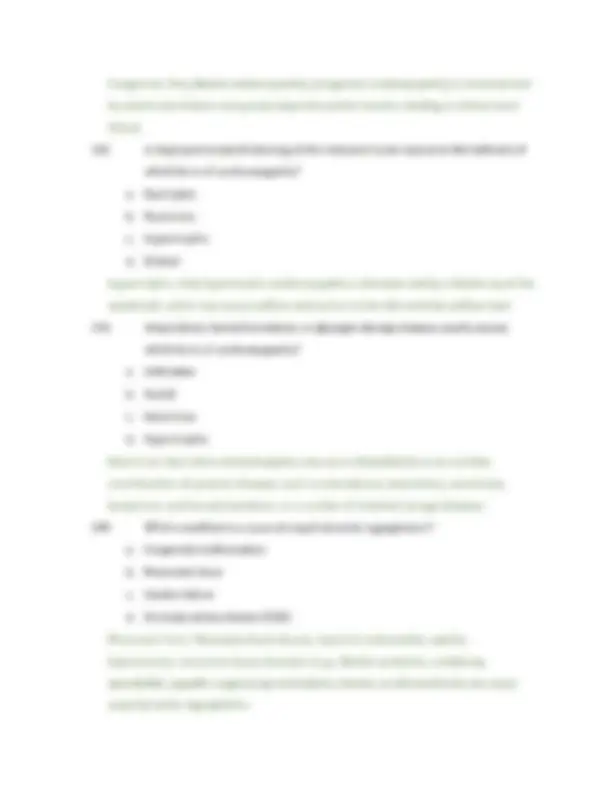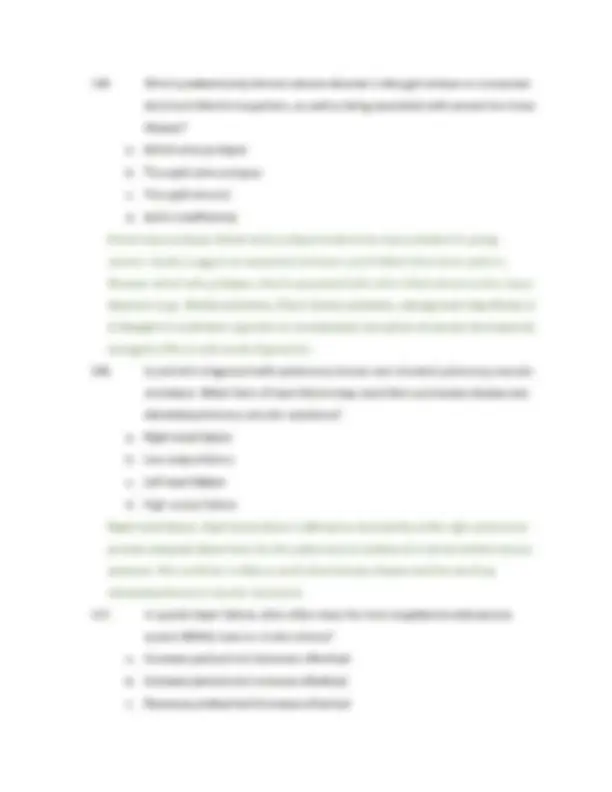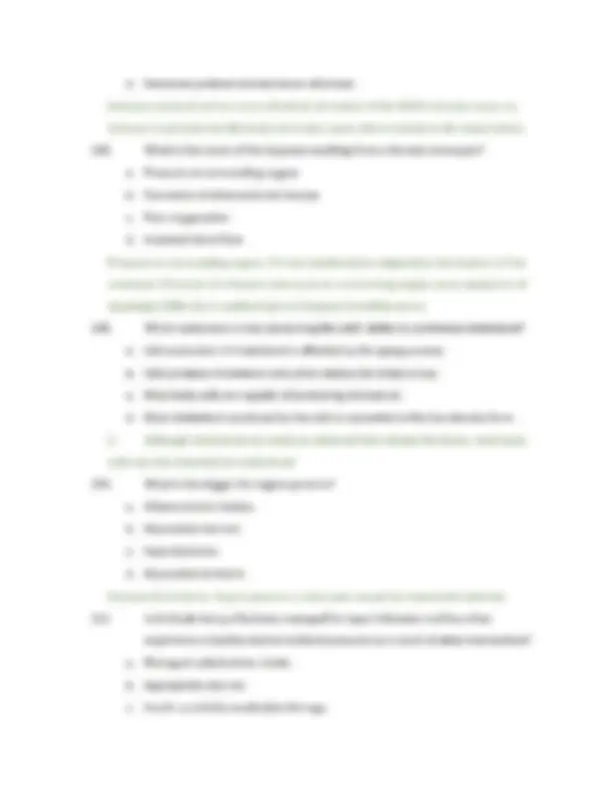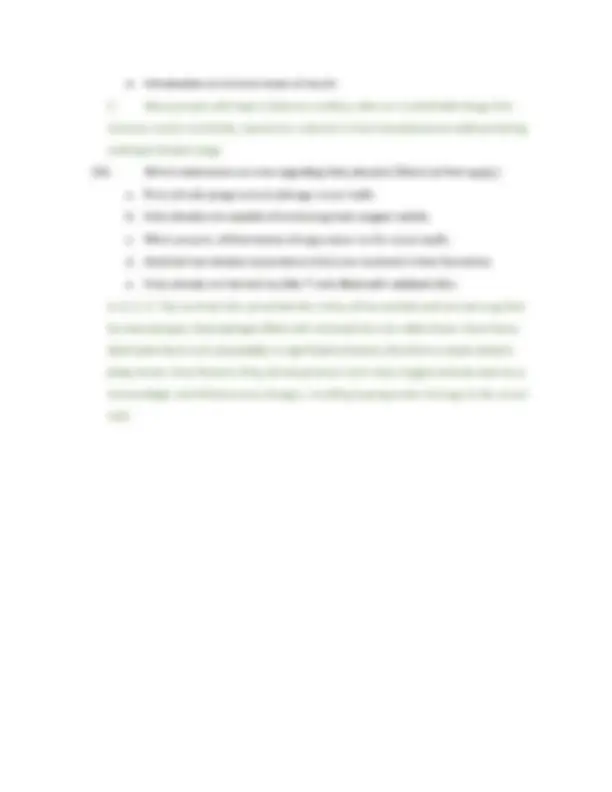Partial preview of the text
Download NURS 611 PATHO EXAM ACTUAL EXAM QUESTION WITH VERIFIED ANSWERS 2025 LATEST VERSIONS and more Exams Pathophysiology in PDF only on Docsity!
What are clinical manifestations of hypothyroidism? a. Intolerance to heat, tachycardia, and weight loss b. Oligomenorrhea, fatigue, and warm skin c. Restlessness, increased appetite, and metrorrhagia d. Constipation, decreased heat rate, and lethargy The lower levels of thyroid hormone result in decreased energy metabolism, resulting in constipation, bradycardia, and lethargy, thus eliminating the remaining options. Thyroid-stimulating hormone (TSH) is released to stimulate thyroid hormone (TH) and is inhibited when plasma levels of TH are adequate. This is an example of: a. Positive feedback b. Neural regulation c. Negative feedback d. Physiologic regulation Negative feedback. Feedback systems provide precise monitoring and control of the cellular environment. Negative feedback occurs because the changing chemical, neural, or endocrine response to a stimulus negates the initiating change that triggered the release of the hormone. Thyrotropin-releasing hormone (TRH) from the hypothalamus stimulates TSH secretion from the anterior pituitary. Secretion of TSH stimulates the synthesis and secretion of THs. Increasing levels of T;and triiodothyronine (Ts) then generate negative feedback on the pituitary and hypothalamus to inhibit TRH and TSH synthesis. Lipid-saluble hormone receptors are located: a. Inside the plasma membrane in the cytoplasm b. c d. On the outer surface of the plasma membrane Inside the mitochondria On the inner surface of the plasma membrane Inside the plasma membrane in the cytoplasm. Lipid-soluble hormone receptors are located inside the plasma membrane and easily diffuse across the plasma membrane to bind to either cytosolic or nuclear receptors. c d. The releasing hormones that are made in the hypothalamus travel to the anterior pituitary via the: Vessels of the zona fasciculata Hypophyseal stalk Infundibular stem Portal hypophyseal blood vessels Portal hypophyseal blood vessels. Releasing and inhibitory hormones are synthesized in the hypothalamus and are secreted into the portal blood vessels through which they travel to the anterior pituitary hormones. (om d. Which mineral is needed for thyroid-stimulating hormone (TSH) to stimulate the secretion of thyroid hormone (TH)? Iron lodide Zinc Copper lodide. TSH, which is synthesized and stored in the anterior pituitary, stimulates secretion of TH by activating intracellular processes, including the uptake of iodine necessary for the synthesis of TH. What effect does hyperphosphatemia have on other electrolytes? Increases serum calcium Decreases serum magnesium Decreases serum calcium Increases serum magnesium induced release of catecholamines from the adrenal medulla), regulate the release of hormones. 10. Which hormone does the second messenger calcium (Ca*) bind to activate phospholipase C through a G protein? a. Angiotensin Il b. Estrogen c. Thyroxine d. Testosterone Angiotensin II. Ca** is considered an important second messenger that facilitates the binding of a hormone (e.g., norepinephrine, angiotensin II) to a surface receptor, activating the enzyme phospholipase C through a G protein inside the plasma membrane. 11. The control of calcium in cells is important because it: a. ls controlled by the calcium negative-feedback laop. b. Is continuously synthesized. c. Acts as a second messenger. d. Carries lipid-soluble hormones in the bloodstream. Acts as a second messenger. In addition to being an important ion that participates in a multitude of cellular actions, Ca** is considered an important second messenger. 12; Where is antidiuretic hormone (ADH) synthesized, and where does it act? a. Hypothalamus; renal tubular cells b. Anterior pituitary; posterior pituitary c. Renal tubules; renal collecting ducts d. Posterior pituitary; loop of Henle Hypothalamus; renal tubular cells. Once synthesized in the hypothalamus, ADH acts on the vasopressin 2 (V2) receptors of the renal duct cells to increase their permeability. 13. How does a faulty negative-feedback mechanism result in a hormonal imbalance? a. Hormones are not synthesized in response to cellular and tissue activities. b. Decreased hormonal secretion is a response to rising hormone levels. c. Too little hormone production is initiated. d. Excessive hormone production results from a failure to turn of the system. Excessive hormone production results from a failure to turn off the system. Negativefeedback systems are important in maintaining hormones within physiologic ranges. The lack of negative-feedback inhibition on hormonal release often results in pathologic conditions. Excessive hormone production, which is the result of the failure to turn of the system, can cause various hormonal imbalances and related conditions. 14. A deficiency of which chemical may result in hypothyroidism? a. Iron b. Zinc c. lodine d. Magnesium Zinc. The only cause of hypothyroidism from among the provided options is a deficiency of endemic iodine. 15. What imbalance lessens the rate of secretion of parathyroid hormone a. Increased serum calcium levels b. Decreased serum magnesium levels c. Decreased levels of thyroid-stimulating hormone d. Increased levels of thyroid-stimulating hormone The overall effect of parathyroid hormone (PTH)is to increase serum calcium and to decrease serum phosphate concentration. 16. Which condition may result from pressure exerted by a pituitary tumor? a. Hypothyroidism b. Diabetes insipidus c. Hypercortisolism 20. When insulin binds its receptors on muscle cells, an increase in glucose uptake by the muscle cells is the result. This is an example of what type of effect by a hormone? a. Pharmacologic b. Synergistic c. Permissive d. Direct Direct. Direct effects are the obvious changes in cell function that specifically result from the stimulation by a particular hormone. 21. Graves disease develops from a(n): a. Viral infection of the thyroid gland that causes overproduction of thyroid hormone. b. Autoimmune process during which lymphocytes and fibrous tissue replace thyroid tissue. c. Thyroid-stimulating immunoglobulin that causes overproduction of thyroid hormones. d. Ingestion of goitrogens that inhibits the synthesis of the thyroid hormones, causing a goiter. Thyroid-stimulating immunoglobulin that causes the overproduction of thyroid hormones. The pathologic features of Graves disease indicates that normal regulatory mechanisms are overridden by abnormal immunologic mechanisms that result in the stimulation of excessive TH. 22. Pathologic changes associated with Graves disease include: a. High levels of circulating thyroid-stimulating immunoglobulins b. Diminished levels of thyrotropin-releasing hormone c. High levels of thyroid-stimulating hormone d. Diminished levels of thyroid-binding globulin High levels of circulating thyroid-stimulating immunoglobulins. The only option that correctly describes the changes associated with Graves disease identifies high levels of circulating thyroid-stimulating immunoglobulins that are found in more than 95% of individuals diagnosed with the disease. 23. 24. & d. The signs of thyrotoxic crisis include: a. Constipation with gastric distention b. Hyperthermia and tachycardia c. Bradycardia and bradypnea d. Constipation and lethargy Hyperthermia and tachycardia The level of thyroid-stimulating hormone (TSH) in individuals with Graves disease is usually: High Normal Low In constant flux Low. The hyperfunction of the thyroid gland leads to suppression of TSH because of the normal negative feedback mechanism. 25. 26. Palpation of the neck of a person diagnosed with Graves disease would detect a thyroid that is: a. Left of midline b. Normal in size c. Small with discrete nodules d. Diffusely enlarged Diffusely enlarged. The effects of the syndrome of inappropriate antidiuretic hormone (SIADH) secretion include solute: Retention and water retention Dilution and water retention Retention and water loss Dilution and water loss Retention and water loss 27. The common cause of elevated levels of antidiuretic hormone (ADH) secretion is: d. Thirst Thirst, is the only symptom in common. 31. The cause of neurogenic diabetes insipidus (D1) is related to an organic a. Anterior pituitary b. Posterior pituitary c. Thalamus d. Renal tubules Posterior pituitary. Neurogenic DI is a result of dysfunctional antidiuretic hormone synthesis, caused by a lesion of the posterior pituitary, hypothalamus, or pituitary stalk. 32. Which form of diabetic insipidus (D1) will result if the target cells for antidiuretic hormone (ADH) in the renal collecting tubules demonstrate insensitivity? a. Neurogenic b. Nephrogenic c. Psychogenic d. Ischemic Nephrogenic. Only nephrogenic DI is associated with an insensitivity of the renal collecting tubules to ADH. 33. Which laboratory value is consistently low in a patient with diabetes insipidus (DI)? a. Urine-specific gravity b. Urine protein c. Serum sodium d. Serum total protein Urine-specific gravity. The basic criteria for diagnosing DI include a low urine-specific gravity while sodium levels are high. Protein levels are not considered. 34. Which form of diabetes insipidus (Dl) is treatable with exogenous antidiuretic hormone (ADH)? a. Neurogenic b. Nephrogenic c. Psychogenic d. Ischemic Neurogenic DI is treated with ADH replacement therapy. 35. The term used to describe a person who experiences a lack of all hormones associated with the anterior pituitary is: a. Panhypopituitarism b. Hypopituitarism c. Adrenocorticotropic hormone deficiency Panhypopituitarism is the only available term that is correctly associated with the lack of all anterior pituitary hormones. 36. Diabetes insipidus is a result of: a. Antidiuretic hormone hyposecretion b. Insulin hyposecretion c. Antidiuretic hormone hypersecretion d. Insulin hypersecretion ADH hyposecretion 37. Visual disturbances are a result of a pituitary adenoma because of the: a. Liberation of anterior pituitary hormones into the optic chiasm b. Pituitary hormones clouding the lens of the eyes c. Pressure of the tumor on the optic chiasm d. Pressure of the tumor on the optic and oculomotor cranial nerves Pressure on the optic chiasm is the only cause for visual disturbances resulting from a pituitary adenoma. 38. Which hormone is involved in the regulation of serum calcium levels? a. Parathyroid hormone (PTH) b. Thyroxine (T,) c. Adrenocorticotropic hormone (ACTH) d. Triiodothyronine (Ts) The parathyroid glands produce PTH, a regulator of serum calcium. The most common cause of hypoparathyroidism is damage caused during thyroid surgery, resulting in a lack of circulating PTH and causing a depressed level of serum calcium. 43. A patient diagnosed with diabetic ketoacidosis (DKA) has the following laboratory values: arterial pH 7.20; serum glucose 500 mg/dl; positive urine glucose and ketones; serum potassium (K*) 2 mEq/L; serum sodium (Na*) 130 mEq/L. The patient reports that he has been sick with the “flu” for 1 week. What relationship do these values have to his insulin deficiency? Increased glucose use causes the shift of fluid from the intravascular to the intracellular space. Decreased glucose use causes fatty acid use, ketogenesis, metabolic acidosis, and osmotic diuresis. Increased glucose and fatty acids stimulate renal diuresis, electrolyte loss, and metabolic alkalosis. Decreased glucose use results in protein catabolism, tissue wasting, respiratory acidosis, and electrolyte loss. Decreased glucose causes fatty acid use, ketogenesis, metabolic acidosis, and osmotic diuresis, which have resulted in the symptoms listed in the question. 44, c d. Polyuria occurs with diabetes mellitus because of the: Formation of ketones Elevation in serum glucose Chronic insulin resistance Increase in antidiuretic hormone Elevation of serum glucose. Glucose accumulates in the blood and appears in the urine as the renal threshold for glucose is exceeded, producing an osmotic diuresis and the symptoms of polyuria and thirst. 45. Type 2 diabetes mellitus is best described as a(an): a. Resistance to insulin by insulin-sensitive tissues b. Need for lispro instead of regular insulin c. Increase of glucagon secretion from a cells of the pancreas d. Presence of insulin autoantibodies that destroy B cells in the pancreas Resistance to insulin by insulin-sensitive tissues. One of the basic pathophysiologic characteristics of type 2 diabetes is the development of insulin-resistant tissue cells. 46. A person diagnosed with type 1 diabetes experiences hunger, lightheadedness, tachycardia, pallor, headache, and confusion. The most probable cause of these symptoms is: a. Hyperglycemia caused by incorrect insulin administration b. Dawn phenomenon from eating a snack before bedtime c. Hypoglycemia caused by increased exercise d. Somogyi effect fram insulin sensitivity Hypoglycemia caused by increased exercise. The most likely cause of these symptoms is hypoglycemia, which is often caused by a lack of systemic glucose as a result of muscular activity. Az. When comparing the clinical manifestations of both diabetic ketoacidosis (DKA) and hyperglycemic hyperosmolar nonketotic syndrome (HHNKS), which condition is associated with only DKA? a. Fluid loss b. Increased serum glucose c. Weight loss d. Kussmaul respirations Kussmaul respirations are only observed in those with DKA and is that “air hunger” or rapid deep labored breathing. 48. Hypoglycemia, followed by rebound hyperglycemia, is observed in those with: a. The Somogyi effect b. The dawn phenomenon c. Diabetic ketoacidosis d. Hyperosmolar hyperglycemic nan-ketotic syndrome 52; 53. 54. 55. om d. Retinopathy develops in patients with diabetes mellitus because: Plaques of lipids develop in the retinal vessels. Pressure in the retinal vessels increase as a result of increased osmotic pressure. Ketones cause microaneurysms in the retinal vessels. Retinal ischemia and red blood cell aggregation occur. Retinal ischemia and RBC aggregation occur. Retinopathy appears to be a response to retinal ischemia and red blood cell aggregation. fom d. Which disorder is caused by hypersecretion of the growth hormone (GH) Cushing syndrome Giantism Acromegaly Myxedema Acromegaly is a term for adults who have been exposed to continuously high levels of GH, whereas the term giantism is reserved for children and adolescents. Gi. d. Which disorder is considered a co-morbid condition of acromegaly? Hypotension Brain cancer Diabetes Thyroid cancer Diabetes. Symptoms of type 2 diabetes mellitus, such as polyuria and polydipsia, may occur. Acromegaly-associated hypertension is usually asymptomatic until symptoms of heart failure develop. Neither thyroid nor brain cancer has been associated with acromegaly. Giantism occurs only in children and adolescents because their: Growth hormones are still diminished. Epiphyseal plates have not yet closed. Skeletal muscles are not yet fully develaped. Metabolic rates are higher than in adulthood. Giantism is related to the effects of growth hormones on the growth of long bones at their epiphyseal plates. This information makes the other options incorrect. 56. Amenorrhea, galactorrhea, hirsutism, and osteoporosis are each caused by: a. Posterior pituitary adenoma b. Prolactinoma c. Thymoma d. Growth hormone adenoma Of the options available, the hallmark of a prolactinoma is the sustained elevation of serum prolactin that is responsible for the symptoms listed. Bz. The signs of thyrotoxic crisis include: a. Constipation with gastric distention b. Hyperthermia and tachycardia c. Bradycardia and bradypnea d. Constipation and lethargy The systemic symptoms of thyrotoxic crisis include hyperthermia and tachycardia. 58. A person has acne, easy bruising, thin extremities, and truncal obesity. These clinical manifestations are indicative of which endocrine disorder? a. Hyperthyroidism b. Diabetes insipidus c. Hypoaldosteronism d. Cushing disease These symptoms are characteristic of Cushing disease and are caused by excessive ACTH secretion. 59. A person may experience which complications as a result of a reduction in parathyroid hormone (PTH)? (Select all that apply.) a. Muscle spasms x b. Tonic-clonic seizures x c. Laryngeal spasms x d. Hyporeflexia 63. 64. 65. 66. om d. Aldosterone directly increases the reabsorption of: Magnesium Sodium Calcium Water Sodium. In the kidney, aldosterone primarily acts on the epithelial cells of the nephroncollecting duct to increase sodium ion reabsorption. fom d. Which is an expected hormonal change in an older patient? Thyroid-stimulating hormone secretion below normal Triiodothyronine level below normal Cortisol level below normal Adrenocorticotropic hormone level above normal Thyroid-stimulating hormone secretion below normal. Aging causes overall thyroidstimulating hormone secretion to diminish but does not bring about the other changes. e. What are actions of glucocorticoids? (Select all that apply.) Decreasing muscle cell reuptake of glucose Fat storage Decreased blood glucose Carbohydrate metabolism Liver gluconeogenesis Decreasing muscle cell reuptake of glucose, carbohydrate metabolism, and liver gluconeogenesis. The term glucocorticoid refers to those steroidal hormones that have direct effects on carbohydrate metabolism. These hormones increase blood glucose concentration by promoting gluconeogenesis in the liver and by decreasing uptake of glucose into muscle cells, adipose cells, and lymphatic cells. Glucocorticoids are not capable of fat storage. a What is the most abundant class of plasma protein? Globulin b. c. d. Clotting factors Albumin Complement proteins Albumin. Albumin (approximately 60% of total plasma protein at a concentration of about 4 g/dl) is the most abundant plasma protein. 67. What is the effect of low plasma albumin? Clotting factors decrease, thus increasing the chance of prolonged bleeding. Fewer immunoglobulins are synthesized, thus impairing the immune function. Less iron is stored, thus increasing the incidence of iron deficiency anemia. Osmotic pressure decreases, thus water moves from the capillaries to the interstitium. In the case of decreased production (e.g., cirrhosis, other diffuse liver diseases, protein malnutrition) or excessive loss of albumin (e.g., certain kidney diseases, extensive burns), the reduced oncotic pressure leads to excessive movement of fluid and solutes into the tissues and decreased blood volume. 68. (om d. The absence of parietal cells would prevent the absorption of an essential nutrient necessary to prevent which type of anemia? lron deficiency Folic acid deficiency anemia Pernicious anemia Aplastic anemia Pernicious anemia. Dietary vitamin B:. is a large molecule that requires a protein secreted by parietal cells into the stomach (intrinsic factor [IF]) to transport across the ileum. Defects in IF production lead to decreased B.; absorption and pernicious anemia. 69. Which nutrients are necessary for the synthesis of DNA and the maturation of erythrocytes? Protein and niacin Cobalamin (vitamin B.2) and folate Iron and vitamin Bs (pyridoxine) 
